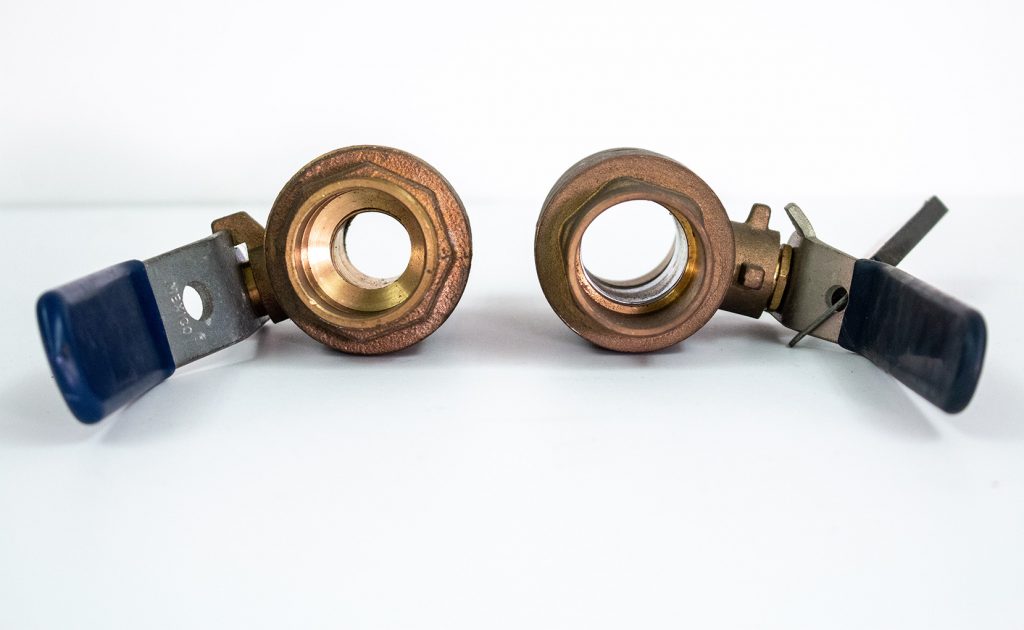4.4 Valves & Prevention Devices
Many devices and faucets are considered to be valves, and numerous valve designs exist and many have multiple uses. Valves and devices installed for potable water must be approved by plumbing codes. Threaded valves and devices typically have female threads, however soldered connections are used for many valves and devices connecting to copper tube and plastic valves and devices are available with solvent welded connections. Backflow devices are installed to protect a potable water system, but an air gap is the only sure method of backflow prevention.
Isolation Valves
Every residential dwelling is required by code to be provided with at least one isolation valve. The valve must be installed in a easily accessible location, so the homeowner can shut off the water supply in case of an emergency or a repair. Most codes require that the minimum size of a residential water service be 3/4”. Actual size is based on the number of plumbing fixtures.
Many codes dictate that the main isolation valve for a house and the isolation valve for a water heater be a full port design. A full port valve has the same inside diameter (ID) as the connecting pipe and does not drastically restrict the volume of water that flows through a valve. Some isolation valves and most devices installed in a piping system have a direction of flow and require an installer to connect the piping system knowing the flow direction of the water or gas.
Types of Isolation Valves & Residential Uses
Ball Valve- Water and Gas: Utilizes an internal ball with a hole in its center that creates a flow passageway through the valve, and isolates flow when the ball is rotated 90° from the flow direction. Some types of ball valves are available with a T-handle, but the most common have a lever handle. The internal ball has a vertical stem protruding from the valve body, to which the lever handle is secured with a tightening nut.
Ball Valve – Full Port vs. Standard by Gwen Arkin is licensed under CC BY 4.0
Gate Valve- Water: Utilizes a metal gate (disc) that slides vertically to open and close the valve. A wheel handle that is fixed to a stem raises and lowers the internal gate when manually turned. The handle is turned counterclockwise to open the valve and clockwise to close the valve. The two basic self-explanatory types of gate valves are a rising stem type and a non-rising stem type.

Gate Valve by Gwen Arkin is licensed under CC BY 4.0
Stop Valve- Water: A valve design that uses a rubber washer to stop the flow of water; it is a directional flow isolation valve. A stop is a restrictive port valve, which is one reason it is no longer widely used in a piping system. A stop is more popular as an individual fixture isolation valve. Commonly installed as the connection between the water distribution system and the fixture tubing connection. Modern fixture supply stops incorporate a 1/4 turn ball valve design in place of a rubber washer assembly to shut off the flow of water. Angled and straight stops for individual fixture isolation are manufactured with chrome and brass finishes. While stops for modern residential applications usually use compression style fittings, older residential and contemporary commercial buildings often are fitted with threaded stops.

Angle Stop by Gwen Arkin is licensed under CC BY 4.0
How To Install a BrassCraft Compression Valve
Stop and Waste Valve- Water: A stop and waste valve uses the same design as a stop valve to isolate an entire water distribution system, except that it also has a draining feature. When freezing is a concern or the need to drain a small portion of a piping system is required, a stop and waste valve is installed. A stop and waste valve cannot be installed in locations where water could enter the water distribution system through the drain portion. Backflow of non-potable water could enter the drain port while the water distribution system was not under pressure. Some ball valves are available with a waste valve feature.
Gas Cock- Gas: Used for gas distribution systems, a gas cock is used more as a means of isolating entire systems, and utility providers commonly use it for isolating gas meters.. Many ball valve designs for gas isolation are manufactured with a T-handle design, which differs from the typical WOG (water, oil, and gas) ball valve lever handle. Many designs do not have a manual handle such as a lever or wheel handle, but require a wrench to open and close the gas cock.A ball valve specifically designed for gas systems is not rated for use with other systems.

Gas Valve by Rosemary Rutherford is licensed under CC BY 4.0
Hose End Outlets
Various types of hose outlet connections are used in a plumbing piping system to drain equipment and systems and for water usage. The most common hose outlet designs are known as a hose bibb, wall hydrant, and boiler drain. Hose threads are different than pipe threads, and outlets are 3/4” male hose threads. A hose connection to a piping system is a primary point of entry of contaminants that pollute a water distribution systemas a result of back siphoning also known as backflow. Back siphoning can occur if a hose connected to a water supply pipe is placed into a contaminated source and the water system becomes depressurized.
Types of Hose End Outlets
Boiler Drain: A hose outlet connection that is designed to drain water heater storage tanks is known as a boiler drain. Boilers and water heaters are protected with other approved backflow devices, so most codes do not require a boiler drain to incorporate an integral backflow device in the design.
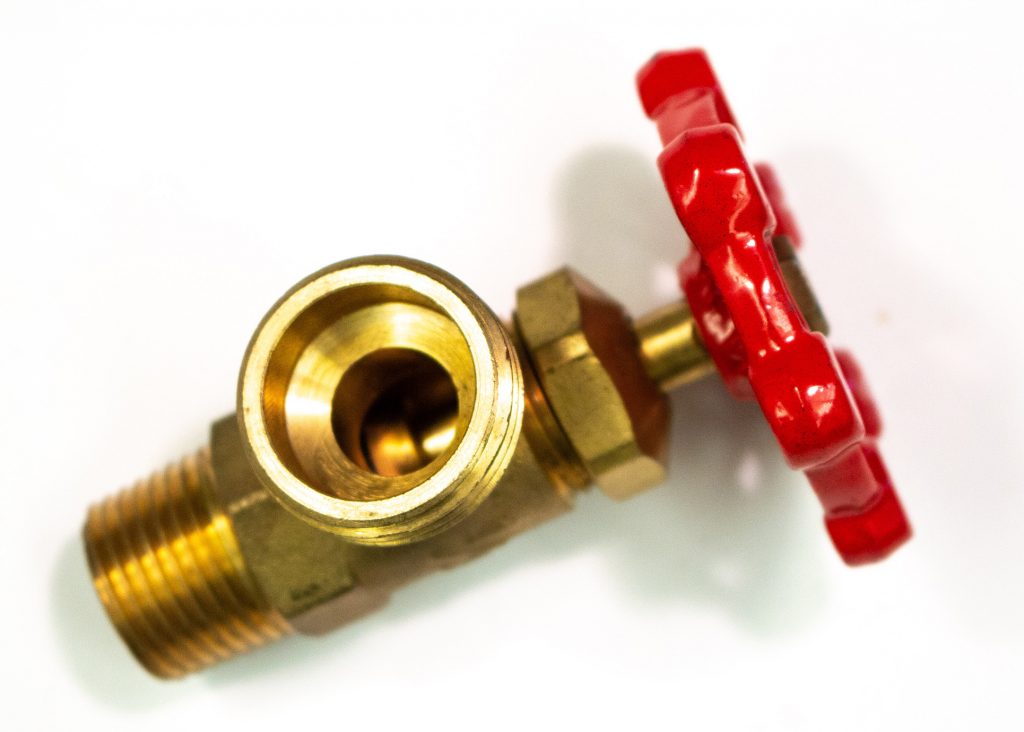
Boiler Drain by Gwen Arkin is licensed under CC BY 4.0
Hose Bibb: Hose bibbs are designed to allow water flow from a pressurized piping system. Some hose bibbs are similar to a boiler drain, and others are a freeze-proof type. Due to their potential to have contaminants enter the potable water system through them, most hose bibbs are required to be protected with a backflow device.

Hose Bib by Rosemary Rutherford is licensed under CC BY 4.0
Protective Valves and Devices
Many valves and devices react automatically to temperature and pressure differences or protect potable water systems from the reversal of flow within a piping system. Protective safety valves and devices can also regulate pressure, discharge high pressure, and discharge high temperature to protect system users and other plumbing system components.
Protective Valves and Devices and Their Uses

Pressure Regulator by Clifford Rutherford is licensed under CC BY 4.0
Pressure-reducing valve (PRV) or Pressure Regulator: Reduces incoming water pressure. For municipal systems or community systems with a water meter, the incoming water supply pressure to a house depends on the design of the municipal or community system. While the optimal operational pressure for most household water supply systems is 40 to 80 pounds per square inch (psi), many municipal water system supply more than 100 psi or pressure to the residence. Excessive pressure in the water supply to a residence must be regulated to prevent pipes and fittings from bursting, and to protect valve seals and connected household appliances from damage due to high pressure. Codes typically allow the water service piping and hose faucets to exceed 80 psi, but piping that serves fixtures must be reduced to a maximum pressure of 80 psi. Most residential PRV styles have an adjustment range from 25 to 75 psi and are factory set to regulate water pressure to 50 psi and can be adjusted with a bolt/locking nut mechanism that reduces or increases the water pressure to the desired setting. An isolation valve should be installed upstream of PRV devices. PRVs are available in a variety of sizes, but 3/4” is the minimum size for reducing the main piping to a standard residence. To check the actual unregulated water pressure to a building, a simple water pressure gauge can be temporarily fitted with an adapter to an unregulated hose bib or faucet on the exterior of the building. Regulated pressure can be checked by adapting the same gauge to an interior faucet or washing machine supply valve.
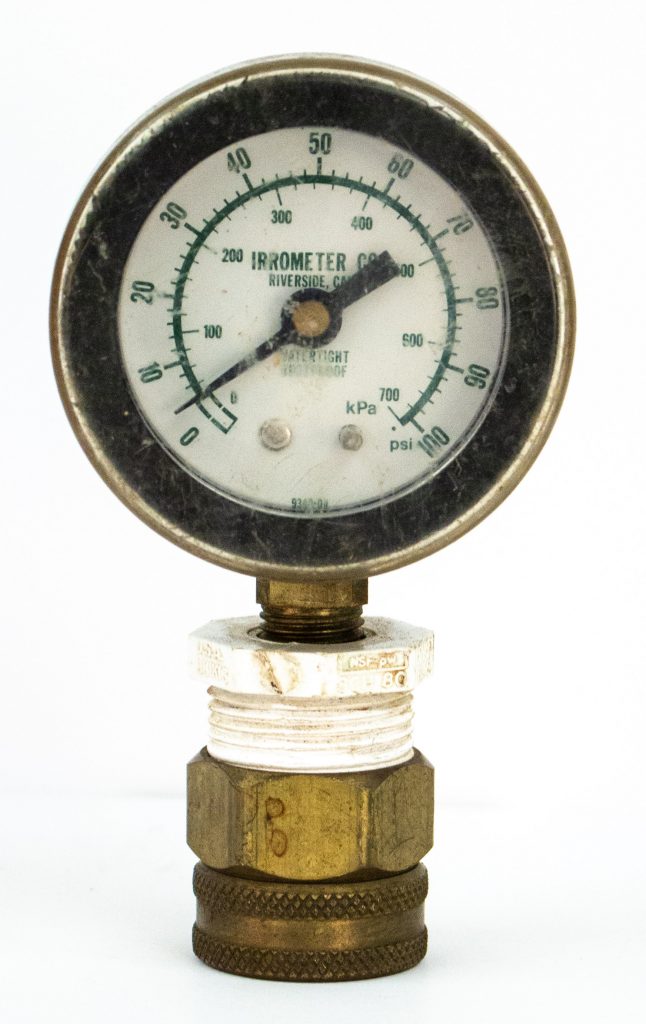
Water Pressure Test Gauge by Gwen Arkin is licensed under CC BY 4.0
Relief valve: Relieves excessive pressure or temperature. Protecting a piping system and attached equipment from extreme temperatures and pressures is the responsibility of a relief valve. All relief valves are self-operating and open and close as they react to the various operating conditions of a system. Many dual-use relief valves provide protection against both temperature and pressure. These are known as T&P relief valves. Most codes require that a water heater be equipped with the proper T&P relief valves before being shipped. While valves used for water heaters on conventional and solar water heating incorporate a T&P valve in the tank design of water heaters, valves for pressure relief only are used on solar water heating panels. Pressure only style valves can be differentiated from T&P valves by the absence of a ceramic coated rod that normally protrudes from the T&P inlet.
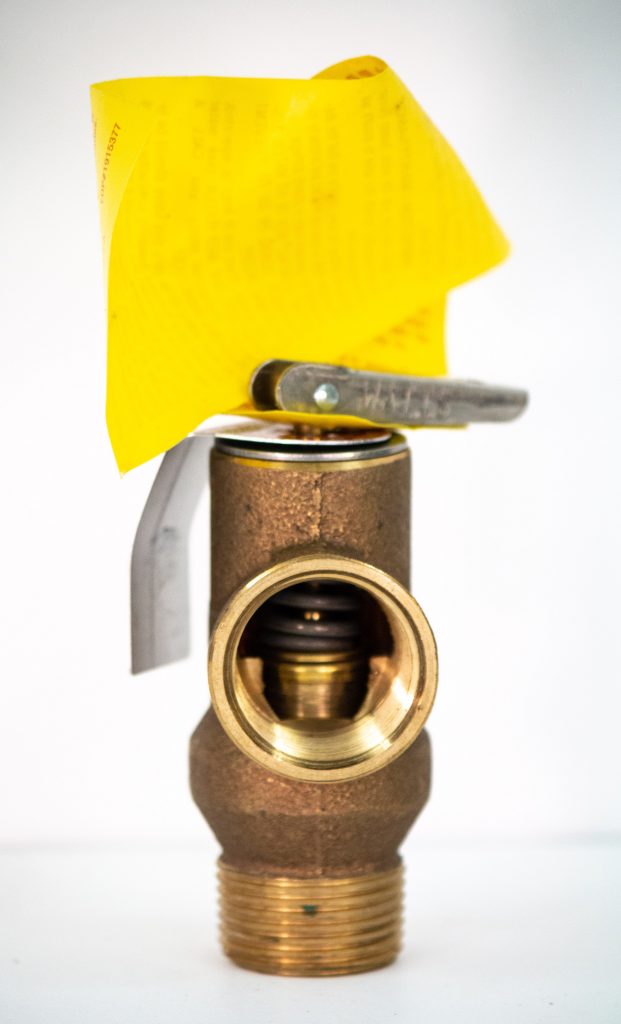
Pressure Relief Valve by Gwen Arkin is licensed under CC BY 4.0
Check valve: Prevents the reverse flow of water or gas. Although check valves are a form of backflow-prevention devices, a single check valve is not an approved method to protect a potable water system from contamination. Swing and spring style check valves are the two most common installed for residential applications. They are installed to ensure the water, or gas, flows in one direction. The swing check style is more common for most water supply applications. The spring check is used more for gas supply and well pump systems.
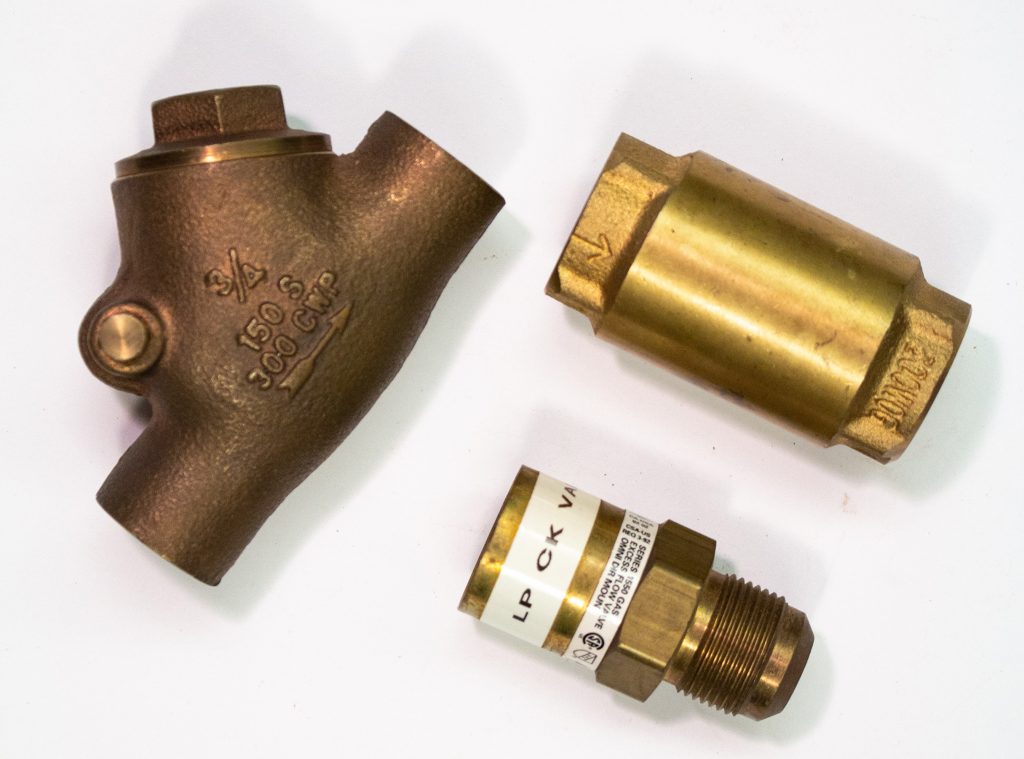
Check Valves Swing, Spring & LP by Gwen Arkin is licensed under CC BY 4.0
Vacuum breaker: Prevents back siphoning. When a water distribution system is isolated or loses pressure, a vacuum is created and can allow contaminated water to enter a potable water system. To prevent the possibility of this type of contamination, a vacuum breakers are installed throughout a piping system. Vacuum breakers are available in several forms.
Vacuum relief valve: Prevents back siphoning. Vacuum relief valves are type of vacuum breaker installed in the cold water piping that serves a water heater. This form of backflow prevention operates when sensing a loss of water pressure. It opens to create an atmospheric condition or to equalize the piping system with atmospheric pressure (zero gauge pressure).
Reduced pressure zone valve (RPZ): Prevents backflow. A reduced-pressure zone valve (RPZ) is the most reliable device installed in a plumbing system as a prevention method to stop the backflow of contaminated water from entering a potable water supply system. If water attempts to backflow in the system, it is discharged from the RPZ.

Reduced Pressure Zone Backflow Preventer by Gwen Arkin is licensed under CC BY 4.0
